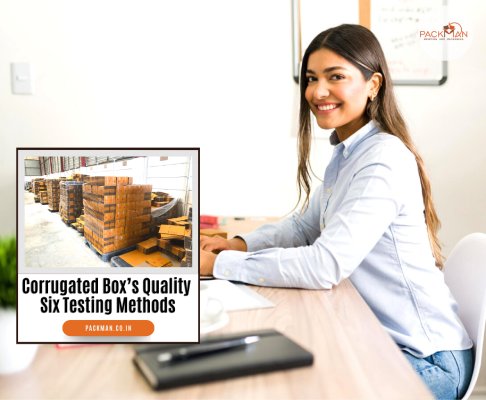Corrugated boxes take up around 30% of the packaging industry alone. This is because corrugated boxes are quite popular. Regular slotted containers, for instance, are one of the most hugely used types of boxes for shipping and storage. Corrugated cartons are low-cost, durable, and eco-friendly. However, not each box is made equal. That is to say, they differ a lot in terms of compressive strength, thickness, chemical resistance, and other factors.
You will need to know this when you have to select a suitable corrugated box for your packaging requirement. The cardboard’s strength and construction straightaway impact the amount of weight a box could carry. A box too weak may puncture or collapse. On the other side, an excessive box means you pay additionally for material and add to environmental wastage.
To determine ways corrugated boxes hold up against external factors — so as to help you Packman Packaging India’s top corrugated box manufacturers and suppliers share an informed decision when choosing boxes — manufacturers use multiple testing procedures. Here they are.
Water resistance of the glueing
- What: Test water-resistance of the glue lines of a corrugated board
- Why: To test the effect of climatic conditions, moisture permeability, water absorption
Although the fiberboard itself can absorb and retain water, testing for water resistance of gluing or sealing is also essential. For specific applications, the FEFCO 9 standard is used to test the water resistance of the gluing for the corrugated cardboard boxes.
In this kind of test, the corrugated board is immersed in water while exposing the glue lines to check for its bond strength and water absorption.
Paper grammage and thickness
- What: Test the areal density and thickness
- Why: To test the box’s quality and rigidity
Grammage and thickness are the two major basic properties of corrugated fiberboards that decide the quality of the box. There is no “best” grammage or thickness categorized in corrugated box specifications and it is fully based on your needs.
When more padding is needed, a box having a higher thickness is used. The flutes of the corrugated board are bigger and pack more air in them. Thin boards having dense flutes have a high grammage. Such kinds of boxes is needed when the packaging needs to be more compact and rigid.
Thickness is generally, measured in (millimetres) and grammage is expressed in terms of grams per square meter (g/m2).
Thinner boards are simpler to fold, lighter, and more suitable when it comes to printing or detailing. Thicker ones are better sturdy and appropriate for heavy-duty shipping. Generally, the type of flute (A, B, C, E, or F) suggests the cardboard strength having C being the most common (4.0mm).
Puncture Resistance
- What: Test resistance to penetration using sharp, solid objects
- Why: To test cardboard’s strength and sturdiness during transportation
Puncture resistance tests how properly the box can handle the effect made with a pyramid or triangularly shaped weight. The corrugated box testing standards for puncture resistance include FEFCO 5 or ISO 3036.
Scuff resistance test
- What: Check the durability of printed or painted boxes to resist abrasion
- Why: To make sure printed text on cardboard box can sustain rubbing, wearing
Printing is an important part of packaging. Having different forms of printing methods being used, it is important to check how well labels or prints are able to handle scuffing or abrasion. For this purpose, scuff resistance or rub proof tests are done. There is one Sutherland Rub Test, which is an industry-standard testing process. Coated surfaces like paper, films, paperboard, and all other printed materials are tested through this procedure.
Also, corrugated box testing methods are also present to test resistance to abrasion. They include rotary abrasion testers and even manual wiping. The Scuff Resistance test is specifically, important for pharmaceutical or medical industries where label legibility is of utter importance.
Box compression test
- What: Tests compressive strength of a corrugated box
- Why: To check the stacking strength of a pallet load
Box compression test, also named container compression test, is a method to test how much load the box could take on top of it prior to it getting deformed and the extent to which it gets deformed. It provides us with a good idea of how many boxes need to be stacked together without damaging the contents of the bottommost box. This test is critical to check the strength of boxes and is needed by most industries transporting boxes in bulk.
The boxes are tested in multiple orientations. If the box design makes utilization of inner supports, like wood support or corrugated board cushioning, then those factors are also taken into account.
The compressive strength of a corrugated box could also be calculated using the McKee formula where the Edge Crush Test (ECT), Caliper or corrugated board thickness (CBT), and box perimeter (P) values are taken into consideration.
Chemical analysis in corrugated box testing
- What: Test resistance of box to chemicals
- Why: To see product formulation and regulatory compliance
Chemical analysis is needed for specific applications where the nature of fiberboard, as well as its resistance to specific chemicals, are checked. The analysis of the fiberboard involves a microscopic examination of the board to observe what sort of paper is used to make the fiberboard. Moreover, the moisture content, along with the pH of the board, is also determined.
For more information on corrugated box testing methods, you may go to our previous blog –Ways To Test The Quality Of Corrugated Boxes





